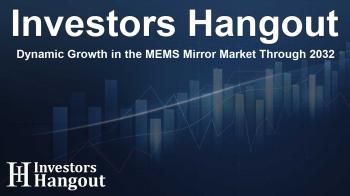Dynamic Growth in the MEMS Mirror Market Through 2032

Forecasting the Future of the MEMS Mirror Market
The MEMS mirror market is witnessing remarkable growth, projected to reach USD 43.62 million by 2032, marking a compound annual growth rate (CAGR) of 5.89%. This growth signals a greater demand for advanced imaging and sensing technologies. As we delve deeper into this segment, we observe various factors fostering this expansion.
The Role of MEMS Technology
MEMS stands for Micro-Electro-Mechanical Systems. These tiny devices operate through complex interactions between mechanical and electronic components. A MEMS mirror, for example, uses electrostatic or electromagnetic forces to create motion. The low power consumption and minimal size make MEMS mirrors perfect for applications needing precise optical deflection, such as in automotive lidar systems.
Adoption in LiDAR Systems
The global MEMS mirror market's growth is principally driven by the rising adoption of LiDAR systems across various industries. LiDAR, which stands for Light Detection and Ranging, utilizes laser light to measure distances with exceptional accuracy. MEMS mirrors are critical in these systems, offering rapid scanning capabilities that are essential for applications in automotive navigation, mapping, and environmental monitoring. The growing interest in autonomous vehicles and smart city infrastructure further amplifies the demand for MEMS mirrors in LiDAR technologies.
Growing Demand for 3D Sensing Applications
Another significant growth factor is the increasing demand for 3D sensing solutions. MEMS mirrors are vital in enabling high-precision scanning needed for technologies such as facial recognition and augmented reality (AR). The adaptability of MEMS mirrors ensures they fit seamlessly into a variety of applications across sectors, from consumer electronics to robotics, making them integral in shaping the technology landscape.
Healthcare Innovations Through MEMS Technology
Integration of MEMS mirrors in the medical sector opens numerous opportunities. Devices reliant on precise imaging, such as Optical Coherence Tomography (OCT), employ MEMS mirrors for high-resolution imaging. This ability allows healthcare providers to visualize biological tissues non-invasively, aiding in diagnostics and treatment planning. The pursuit of improved patient outcomes will likely catalyze the adoption of MEMS mirror technology in healthcare diagnostics.
Impact on Augmented and Virtual Reality Technologies
Advancements in augmented and virtual reality technology also point toward increased MEMS mirror adoption. As these technologies become more mainstream in sectors such as gaming, education, and training, the demand for capable optical components rises. MEMS mirrors offer solutions that enhance performance and provide rich visual experiences, making them a foundation in future AR/VR innovations.
Noteworthy Developments and Market Trends
Recent developments suggest an enthusiastic investment climate in the MEMS mirror market. For instance, a notable startup is ramping up production capabilities with significant funding, emphasizing the viability of MEMS mirrors in addressing current technological challenges. Collaborations within the industry indicate a concerted effort to enhance production efficiency and material quality to meet growing applications across numerous sectors.
Key Industry Players
A variety of companies are leading the MEMS mirror market space, including Analog Devices, Boston Micromachines, Broadcom, and Hamamatsu Photonics. These organizations contribute significantly to research and development, continually pushing boundaries in MEMS technology applications. Keeping track of these key players can offer insights into market trajectories and potential innovations on the horizon.
Conclusion: The Bright Future Ahead
In conclusion, the MEMS mirror market is poised for dynamic growth driven by technological advancements in various industries. From automotive applications utilizing LiDAR to healthcare innovations and immersive experiences in AR and VR, MEMS mirrors are set to become essential in advanced systems. As this market evolves, continuous investment in research and development will pave the way for exciting breakthroughs, ensuring a prosperous future.
Frequently Asked Questions
What is the projected growth of the MEMS mirror market?
The MEMS mirror market is projected to reach USD 43.62 million by 2032, growing at a CAGR of 5.89% from 2024 to 2032.
How do MEMS mirrors function?
MEMS mirrors operate using electromagnetic principles to create motion, enabling precise optical deflection in compact designs.
What industries are driving the demand for MEMS mirrors?
Industries such as automotive (LiDAR systems), healthcare (imaging technologies), and consumer electronics (3D sensing) are significantly driving demand.
What role do MEMS mirrors play in healthcare?
MEMS mirrors are critical in high-resolution imaging used in medical diagnostics, particularly in technologies like Optical Coherence Tomography (OCT).
Who are the key players in the MEMS mirror market?
Key players include Analog Devices, Boston Micromachines, Broadcom, and Hamamatsu Photonics, all known for their contributions to MEMS technology.
About The Author
Contact Thomas Cooper privately here. Or send an email with ATTN: Thomas Cooper as the subject to contact@investorshangout.com.
About Investors Hangout
Investors Hangout is a leading online stock forum for financial discussion and learning, offering a wide range of free tools and resources. It draws in traders of all levels, who exchange market knowledge, investigate trading tactics, and keep an eye on industry developments in real time. Featuring financial articles, stock message boards, quotes, charts, company profiles, and live news updates. Through cooperative learning and a wealth of informational resources, it helps users from novices creating their first portfolios to experts honing their techniques. Join Investors Hangout today: https://investorshangout.com/
The content of this article is based on factual, publicly available information and does not represent legal, financial, or investment advice. Investors Hangout does not offer financial advice, and the author is not a licensed financial advisor. Consult a qualified advisor before making any financial or investment decisions based on this article. This article should not be considered advice to purchase, sell, or hold any securities or other investments. If any of the material provided here is inaccurate, please contact us for corrections.

